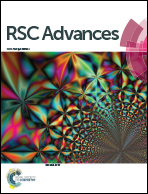A highly selective turn-off fluorescent probe for Cu(ii) based on a dansyl derivative and its application in living cell imaging†
Abstract
A novel dansyl derivative (1) was designed and synthesized with high yield. It is highly selective for Cu2+ over other competing metal ions such as Ca2+, Co2+, Cr3+, Cu+, Fe2+, Ga3+, Hg2+, Mg2+, Na+, Ni2+ and Pb2+. Zn2+ and Fe3+ only slightly changed the fluorescence of probe 1. The linear relationship between fluorescence intensity and Cu2+ concentration indicates that 1 can be used for quantification. The binding ratio of probe 1 to Cu2+ was found to be 1 : 1 according to Job's plot experiments. Probe 1 can be used in a broad pH value window ranging from 5 to 11. The limit of detection (LOD) based on 3 × δblank/k was calculated with a value as low as 1.6 × 10−6 M for Cu2+. Additionally, the association constant of probe 1 − Cu2+ complexes was found to be 5.08 × 104 M−1. Moreover, fluorescence microscopy experiments showed that 1 can be used as a fluorescent probe for evaluating the presence of exogenous Cu2+ in living cells.


 Please wait while we load your content...
Please wait while we load your content...